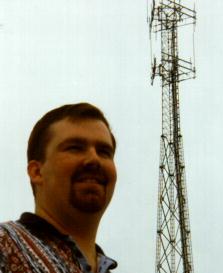By Scott L Miley
STAFF WRITER

Photo Scott Miley
TALL THINKING: Tim Thompson says cell phone towers will be phased out.
MUNCIE, Ind. - If Timothy Thompson can predict the future, cellular phone towers won't be needed 10 years from now.
By then, cell phone calls will bounce off satellites floating high above the cornfields and interstates where once stood those spindly obtrusive metal towers.
"I think a good portion of them will come down ... I really can't see what type of technology will use those once the technology's there to go to direct satellite," said Thompson, a recent Ball State University graduate.
He's only 23, but his views are circulating among city planners, including some in the Metro North area.
Thompson has no quartz crystal hall.
He's never even used a cellular phone.
He was merely a Ball State University College of Architecture and Planning student
in search of a thesis when he latched onto the greatest building trend since the
corner video store.
Thompson, a New Hampshire native, received a summer internship in 1996 with town planners in Londonderry, N.H. His boss asked him to look into the growing tower phenomena. By the time he went back to Ball State, the issue developed into a thesis.
"I couldn't think of anythiig else to do," he acknowledges with collegiate aplomb. Now the thesis is on his personal Web page. City planners are quietly calling it up. There, they find six steps for local governments to take in meeting the wireless challenge. For cities without wireless communications laws, Thompson suggests placing a 90-day moratorium on applications from companies that want to build towers. That will give planners time to shore up ordinances.
"If you don't say you're going to do this up front, somebody will take advantage of it," Thompson said.
He suggests towers serve more than one provider of cell phone serices, a strategy known as co-location. That might limit the proliferation of towers. Towers are needed every 20 miles or so - they are more frequent in heavily traveled areas - so that transmission is cleaner for the radio frequencies bouncing between cellular phones and towers.
There should be 100,000 of these towers in the United States by the year 2000, according to communications industry predictions. Some communities are being caught off-guard when a cell phone company comes seeking a building permit for a tower.
And that's the heart of the matter, said Thompson. Local governments must develop regulatory guidelines, not only to build wireless towers but to take them down again.
If a tower hasn't been used for 180 days - Thompson's thinking into the future again - then a city should be able to tear it down and charge the cell phone provider for its removal.
Planners should avoid placing towers in neighborhoods. "Residential areas should be the area of last resort just because of the uproar from residents," said Thompson.
These seemingly balanced suggestions come from a young adult who drives a minivan, reads Clive Cussler and listens to heavy metal music.
Thompson, [now Town Planner in Londonderry, NH...back where it all began...], has gained respect not only for snagging a hot topic as his thesis but in wisely evaluating the future role of towers without taking sides.
"The thing that jumps out most is that the research is impeccable," said Tony Allender, Boone County planner.
"He's looked at it in a very unbiased way, which planners should do. He's looked at all sides and various options, and he hasn't looked at it as absolutely coming from a community perspective or absolutely from a developer's perspective."
"He tries to promote something that works for everybody."
For example, Thompson studied Noblesville's new tower ordinance. Noblesville officials are trying to keep towers in industrial and business areas, limiting tower height to 200 feet. The city even wants color coding to camouflage the tower with the surrounding architecture.
Those initiatives were hailed by Thompson. But, he noted, Noblesville needed better definitions for what constitutes a wireless communication facility. For example. there's no specific mention of satellite dishes or future spectrum-based facilities.
Noblesville's four-line definition addresses antennas, towers and support buildings for private or commercial communications such as television, radio or commercial mobile radio.
Thompson may be right, acknowledged Noblesville's Planning Director Steve Huntley.
"The definitions are critical and as we work through this thing and have more problems come. we'll probably be increasing definitions," said Huntley.
Thompson reviewed the regulations at Fishers, which he personally calls "tower heaven." In his thesis, he notes simply: "Co-location can solve Fishers' problem in a heartbeat."
Still, Thompson won't be too critical of Fishers. His roommate, Brian Harvey, works for Fishers' Planning Department.
Yet, in his thesis, Thompson noted there are 12 towers around Fishers, with two more awaiting construction. He urges Fishers to make sure providers share towers.
The need for municipalities to control tower sites is critical.
By coincidence, within a few days of Thompson completing his thesis, a representative of Sprint PCS met with Carmel city officials seeking an emergency tower setup. Sprint had been advertising its service would be available by a certain date, yet Carmel had placed a moratorium on towers until an ordinance was written. As a compromise, Carmel let Sprint place one antenna on a city water tower and another antenna atop a temporary phone pole.
Thompson just nods in acknowledgment.
"The technologies are changing rapidly ... if a municipality does not act now, it may be too late."